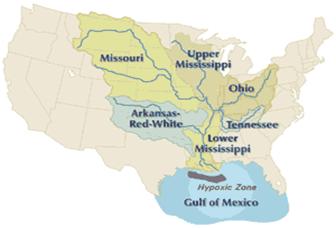Collaboration and Partnerships
Note: EPA no longer updates this information, but it may be useful as a reference or resource.
Building Innovative Industry-Producer Partnerships to
Reduce Hypoxia in the Gulf of Mexico
EPA Region 4 - Atlanta
Geographic location or area of activity: Gulf of Mexico, Mississippi Delta, and communities surrounding the Mississippi River
 Description of activity: Forming new partnerships between industry leaders and agricultural producers in the Mississippi River Basin will bring innovative, effective approaches for addressing complex nutrient management challenges directly to the local level. The project will facilitate the identification of nutrient reduction strategies, formation of local producer coalitions and development of nutrient reduction management plans. The interconnectedness of our water
Description of activity: Forming new partnerships between industry leaders and agricultural producers in the Mississippi River Basin will bring innovative, effective approaches for addressing complex nutrient management challenges directly to the local level. The project will facilitate the identification of nutrient reduction strategies, formation of local producer coalitions and development of nutrient reduction management plans. The interconnectedness of our water
systems is more apparent at the local level.
Each summer dissolved oxygen levels are depleted by decaying algae in the Gulf of Mexico; thereby, creating an enormous hypoxic zone, or “dead zone”. The result is an aquatic ecosystem temporarily unable to support fish and other life. The algae that cause the hypoxic zone are fed, in part, by nutrient runoff from the entire Mississippi River Basin – a drainage area of over 40 percent of the United States. The sources of those nutrients can potentially include failing septic systems in Nebraska, sewer overflow in up-state New York, lawn fertilizer in Ohio or excessive application of nutrients on cropland in Iowa. The sources are many, but the USEPA's Gulf of Mexico Program has committed to “support national efforts to reduce the five-year running average areal extent of the Gulf hypoxia zone to less than 1,930 square miles (5,000 square kilometers) by 2015.” It’s an optimistic goal that will require addressing nutrient reduction from numerous sources and a wide variety of solutions unique to each nutrient source. One solution in the agriculture industry is proper application of nutrients to cropland. EPA has funded several projects to encourage this practice.
Project Goals:
- Increase agricultural industry leaders' involvement in identification of effective approaches to address nutrient management challenges in the lower Mississippi Basin
- Increase applications of best available technologies in local nutrient reduction management plans targeted at reducing nutrient loads to the Mississippi River.
- Create a model for transferring best available industry technology to the local level
- Provide project summaries from industry, producers and other stakeholders at a Mississippi River Basin conference for review of project outputs and outcomes.
- Produce a conference summary that provides a model template for creating successful industry-producer partnerships and effective nutrient management in the sub-basins
Interagency partners: Environmental Protection Agency; Department of Commerce;
Department of Transportation; Department of Health and Human Services; Department of Agriculture; Department of Interior; Department of Homeland Security; National Aeronautics and Space Administration
Local partners: Agriculture Interests Groups; Environmental Interests Groups; Business and Industry interests Groups; States of Alabama, Florida, Louisiana, Mississippi, and Florida; Cities and counties on the Gulf Coast
Activity URLs: https://www.epa.gov/gmpo, https://www.epa.gov/gmpo/lmrsbc/index.html
![[logo] US EPA](../gif/logo_epaseal.gif)